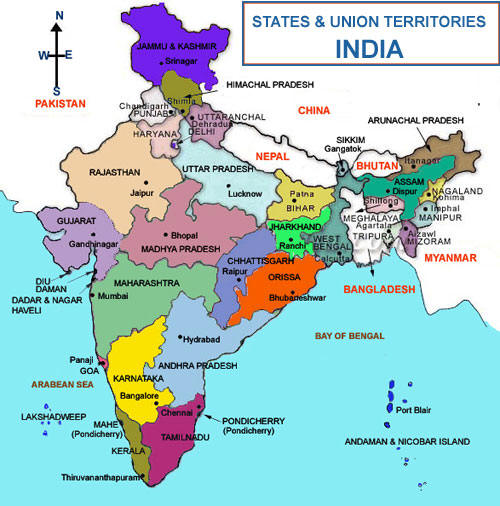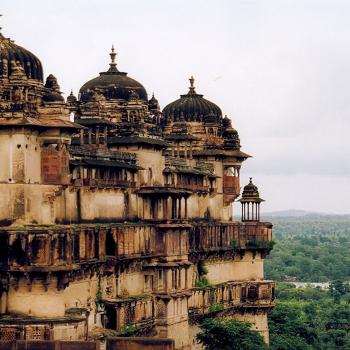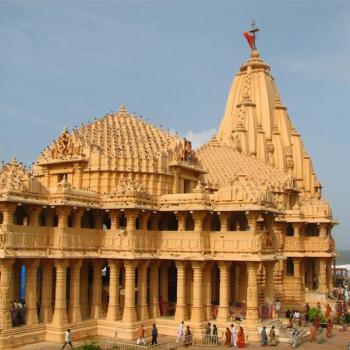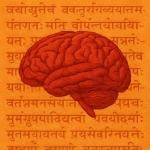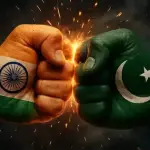If you are looking for some amazing and interesting facts about India, check out our 12 amazing facts about India section below. If you are looking for information on the the country, continue reading.
Geography: India’s area of 3,287,263 sq km (1,269,212 sq miles) makes it the seventh largest country in the world. It stretches 3214 km (1997 miles) from Kashmir south to Kanyakumari on the Indian Ocean, and 2933 km (1823 miles) from the eastern frontier with China and Burma to the Gujarat coast on the Arabian Sea. The Himalayas mark the northern frontier, leading down to the plain of the Ganga river stretching east to the Bay of Bengal.
In the northeast, Cherrapunji holds the record for the world’s heaviest rainfall in a single year, 22,990 mm (905 inches) in 1861. The triangular Deccan plateau of the southern peninsula is flanked by the Vindhya and Satpura mountains in the north and the Eastern and Western Ghats which run parallel to the Coromandel and Malabar coasts.
Highest mountain: Kanchenjunga (Sikkim) 8,586 m (28, 168 ft)
Population: 1210 million, of whom 72% are Indo-Aryan, mostly in north, 25% Dravidian in south, 3% others. Density is 313 people per square kilometer (750 per square mile).
Capital: Delhi, pop. 11,300,000
Major cities: Mumbai (once Bombay), pop. 15,000,000; Calcutta, pop. 12,000,000; Hyderabad, pop. 4,900,000; Bangalore, pop. 5,200,000; Chennai (once Madras), pop. 5,900,000; Ahmedabad, pop. 3,600,000; Pune, pop. 2,800,000; and Kanpur, pop. 2,470,000.
Government: India is a republic of 25 states, with seven union territories governed from Delhi. A member of the British Commonwealth, it has parliamentary government established by the 1950 constitution. The President has limited responsibility, real power being vested in a Prime Minister and Council of Ministers responsible to the 544 members of the Lok Sabha (House of the People). State government is in the hands of Chief Ministers and State legislatures, which is represented centrally by a 244-member Rajya Sabha (the Council of States).
Religion: 82.6% Hindu, 11.4% Muslim, 2.4% Christian, 2% Sikh, 1.6% Buddhist, Jain, and others.
Electrification: 94% villages are deemed electrified as of 2013. However, a village is said to be electrified if all public spaces and just 10% of the households have electricity access. In terms of households, 43% of rural households (73 million) depend on kerosene for lighting. 0.5% (1 million) have no lighting access at all. According to the International Energy Agency, 288 million Indians had no access to electricity as of 2009.
Internet Usage: 243 million users, behind China (642 million) and the United States (280 million). India is expected to push past the United States by the end of 2014, with a yearly growth of 14%. 500 million users are expected to log on from India by 2018.
About India
India (भारत) is exhilarating, exhausting, and infuriating – a land where, you’ll find, the practicalities of daily life overlay the mysteries that popular myth attaches to India. In place of the much-publicized, and much misunderstood, mysticism of its ancient religions, India in reality has quite another miracle to offer in the sheer profusion of its peoples and landscapes.

India comprises a diamond-shaped subcontinent that stretches over 3,000 km (1,800 miles) from the Kashmir mountains in the north right down to Kanyakumari, or Cape Comorin on the Indian Ocean. From east to west India also covers about 3,000 km, from Arunachal Pradesh and Assam on the border with its neighbors China and Burma to the Gujarat coast on the Arabian Sea. Only in more recent post-colonial times did its natural geography exclude the countries of Pakistan and Bangladesh. Even there, for all the hostilities, there’s an undeniable cultural affinity with India – feuding brothers rather than unrelated strangers. In fact, when you look at its 4,000 years of history – or any of today’s newspapers, for that matter – its countless feuds seem to be a perpetual but necessary dynamic of Indian culture and civilization. India is a massive family, with a lot of different and inevitably conflicting regional and sectarian interests.
Rupee banknotes are printed in India’s 15 official languages: Hindi, Urdu, Sanskrit, Sindhi, Bengali, Marathi, Gujurati, Oriya, Punjabi, Assamese, Kashmiri, and Malayalam, as well as Kannada, Tamil, and Telugu. A count of the languages spoken all over India, leaving out the dialects, comes to 1652, written in 13 different alphabets. The national language of Hindi is spoken by less than the majority, and English is spoken by people mostly in the bigger towns and cities.
India’s prehistoric settlers were probably what anthropologists call Proto-Australoids. They’ve since been joined by Mongols, Aryans, Greeks, Arabs, Turks, Persians, and Afghans, while Dutch, British, Portuguese, and French have also left their traces. The landscape is alternately rich and arid, lush and desolate. The majestic Himalayas in the north make an appropriate home for Shiva, one of the most-revered Hindu gods. Kashmir is a serenely beautiful and coveted land of green forest, alpine meadows, and lakes, while the Punjab in the northwest is the fertile center of the country’s Green Revolution, supporting the nation’s self-sufficiency in wheat, barley, and millet.
On the doorstep of this wealth, the Thar Desert of noble Rajasthan heralds the vast Deccan plateau of parched, ruddy granite that dominates the peninsula of southern India. Delhi stands at the western end of the Ganga (Ganges) river basin in which India grows much of its rice. Flanked with patches of forest leading up into the foothills of the Himalayas, the flat plain stretches right across to the Bay of Bengal 1600 km (1000 miles) away, but some areas are kept as nature reserves for the country’s wildlife, notably its tigers, leopards, and elephants.
Bengal’s greenery is the threshold to the tea plantations of Darjeeling and Assam. The rugged southern peninsula is hemmed in by low-lying mountains- the Vindhya and Satpura to the north and the Western and Eastern Ghats running parallel to the coast. The forested Malabar coast in the west is sown with crops of coconut, betel-nut, pepper, rubber, and cashew nut, which today still tempt ships across the Arabian Sea. Some of the palm trees in the area provide shade for beach resorts in Goa and Kerala.
India’s landscape also features man-made architectural treasures, bearing witness to the many great religions and civilizations which have enriched the country. Over 3650 monuments (3683 as of 2014), after centuries of neglect, are now preserved by the restoration program started by the Archaeological Survey of India. The sights are endless: the Hindu gopuram tower-gates of the south, the temples of Varanasi (Benares), the cave monasteries of Ajanta and Ellora, the beautiful and erotic sculptures of Khajuraho, the splendid marble palaces, fortresses, and mausoleums of the emperors and maharajas in Delhi, Agra, and Rajasthan, the colonial government buildings in New Delhi, or the unusual style of the Gothic-Oriental railway station in Mumbai (known until 1995 as Bombay).
The cities’ shanty-town districts are often directly in the shadow of the shining skyscrapers, built by the shanty-town residents themselves. Here women carry bricks on their heads as gracefully as a pitcher of water. The women are also responsible for one other characteristic of Indian “architecture” – cow-dung patties which are preserved and kept for fuel and artfully shaped into mounds with shapes that differ from region to region, one of them resembling a Buddhist stupa, a Hindu gopuram, or even a Moslem minaret.
The only constant in this huge landscape is the people themselves. Even in the vast open spaces of the Rajasthan desert or the Deccan plateau of central India, people appear everywhere, a tribesman on camel-back or lone woman holding her headdress in her teeth to keep out the dust as she carries a huge pitcher of water or a bundle of firewood on her head. If, as the road stretches before you empty and clear right up to the horizon, and you can see only one tree, it’s a pretty safe bet you’ll find at least one sadhu (holy man) resting in its shade.
12 Amazing Facts About India
1. India’s current population is about 1.25 billion. I’m sure you knew that already. Well, did you know that India’s 2001 population census had a margin of error of 2-3%. That’s about 20-30 million people. In effect, the margin of error in India’s census is more or less the same as the population of Saudi Arabia, and over twice the global Jewish population. 2.5 million census officials visit households in over 7000 towns and 600,000 villages over a period of 11 months. It consumes 11 million tons of paper and costs INR 6000 crores or $1 billion dollars.
2. Speaking of population, three of the ten largest urban agglomerations in the world are in India. (China has only two in the top ten for comparison). Delhi, Mumbai and Kolkata make it to the list, with Delhi being number 2 with 23 million people (as of 2011). Nearly 57 million people live in these three cities alone. If they were a country, they would be the 25th most populous country, just ahead of South Africa.
3. One last population fact, India’s most populous state is Uttar Pradesh, with a population just under 200 million. If it were a country, it would be the sixth most populous nation, just behind Brazil.
4. The Indian Railways is the fourth largest rail network, behind the United States, Russia and China, with 60,000 kilometers of track. Amazingly, it carries 24 million passengers every day! That’s more than the population of Australia. The railways is the largest non-military employer in the world and has 1.4 million people on its rolls, a tad more than the population of Estonia.
5. The People’s Linguistic Survey of India estimates that there are 780 languages confirmed to exist in India, and another 100 that they suspect exist. The government’s official language count is 122 since it does not count languages spoken by fewer than 10,000 people. In the last 50 years, 220 languages have gone extinct, and another 150 might follow the same path over the next 50 years. The survey involved 3000 volunteers and took four years to complete. The 35,000-page document is being released in 50 volumes. What’s the rarest language in India? Probably Chaimal, spoken by four or five members of the Chaimal tribe of Tripura.
6. The Himalayas are the tallest and among the youngest mountain ranges in the world. There are 95 Himalayan peaks that top 7500 meters in altitude. Every one of the 100 highest peaks in the world is in the Himalayas. In fact, the highest peak outside of the Himalayas is Aconcagua in Argentina, at 6960 meters, almost 2000 meters or 2 kilometers lower than Everest. Note that the Himalayas aren’t restricted to India but cover Pakistan, a bit of Afghanistan, China, Burma, Nepal, Bhutan and a sliver of Tajikistan as well.
7.The Kumbh Mela in 2013 was the largest gathering of human beings on earth – ever. 120 million people are estimated to have visited Prayag, the confluence of the rivers Ganga, Yamuna and mythical Saraswati, over 55 days. 30 million people are thought to have been present on February 13th, the most auspicious day.
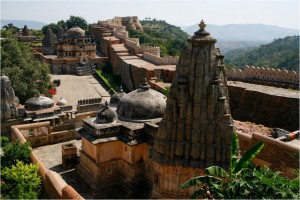
The massive wall is 15 feet wide in places, with avenues for guards to walk about and slits for archers to shoot from, at the top. The wall protected the fort during the many wars that raged between Mewar and its neighbor Marwar. The fort has fallen only once in its 500 years of occupancy, when the inhabitants within ran out of water. The wall encloses about 360 temples in the fort, of which 60 are Hindu temples, and the rest Jain ones.
9. The Indian postal network is the largest in the world, with 155,015 post offices, 90% of which are in rural areas. That’s a seven-fold increase on the 23,344 post offices in India at the time of Independence. On average, there is a post office for every 21.21 square kilometers, serving a population of 7175 people. India’s first post office was opened in 1774 by Warren Hastings, but the Indian Postal Service as a system officially came into existence only in 1837. British India also introduced Asia’s first adhesive stamp in 1852, the “Scinde Dawk” or “Sindh Dhak”, meaning the post of Sindh (a region in modern-day Pakistan).
In today’s age of emails and the Internet, the post office has seen a decline of almost 50% over the last decade in deliveries of letters and postcards and a 70% fall in parcels. However, there has been a 20% rise in packet deliveries (containing stuff like ID cards etc.), and a three-fold increase in revenue to INR 10,000 crore ($1.67 billion) thanks mostly to the 500% rise in deposits in the postal services savings account scheme. The postal service currently has about INR 90,000 crore ($15 billion) in deposits as part of its savings scheme. Over the last few months, they’ve been connecting hundreds of post offices to create a banking network of 23,000 branches by 2015. That’s more than the State Bank of India, the current leader that is state-owned. They are also setting up ATMs at 2,800 locations by 2015.
10. India is the only country that is home to five big cat species – the bengal tiger, asiatic lion, indian leopard, snow leopard and clouded leopard. There are about 2500 bengal tigers left in the wild, of which 1700 are found in India. There are 411 asiatic lions in the wild (as of 2010), all of which are confined to the Gir Sanctuary in Gujarat. Though this number may seem dismally low, it is a great improvement over the dozen individuals that survived at the turn of the twentieth century.
The Indian leopard’s wild population is estimated at between 10,000 and 20,000. Due to habitat destruction, they are often found near human settlements, and even in the city of Mumbai! The snow leopard lives in the Himalayas at elevations of over 3000 meters, and as such, only a rough estimate of its population is known. 4000-6000 individuals are thought to live across its range in the Himalayas and parts of Central Asia. Country-wise estimates are not known. The clouded leopard presents a similar problem. Instead of snowbound peaks, the trouble here is tropical jungle. Fewer than 10,000 mature individuals are thought to exist in the wild.
11. 125 species of ants are known to exist in the city of Bangalore alone. Compare that to the 100 or so species found in the whole of Canada and it gives you an idea of Bangalore’s diversity. There is even a species, first discovered in Bangalore, named dilobocondyla bangalorica. Bangalore, which lies amidst the rich green forests of the Western Ghats, is home to wide variety of flora and fauna despite being an IT hub and “Silicon Valley of India.” There are over 670 ant species in India as a whole.
12. Off to the movies now! Bollywood, as India’s Mumbai-based film industry is known, puts out over 1000 films a year (twice as much as Hollywood’s output), making it the globe’s largest film-making industry. Indian movies got their start on May 3, 1913, with the black-and-white, silent flick “Raja Harischandra”. No one called it Bollywood’s first movie back then because the term “Bollywood” came into existence only late in the twentieth century when the West took an interest in Hindi cinema. But movies aren’t as much a craze among Indians as these figures suggest. Only 4% or 45 million Indians go to the theater regularly.

